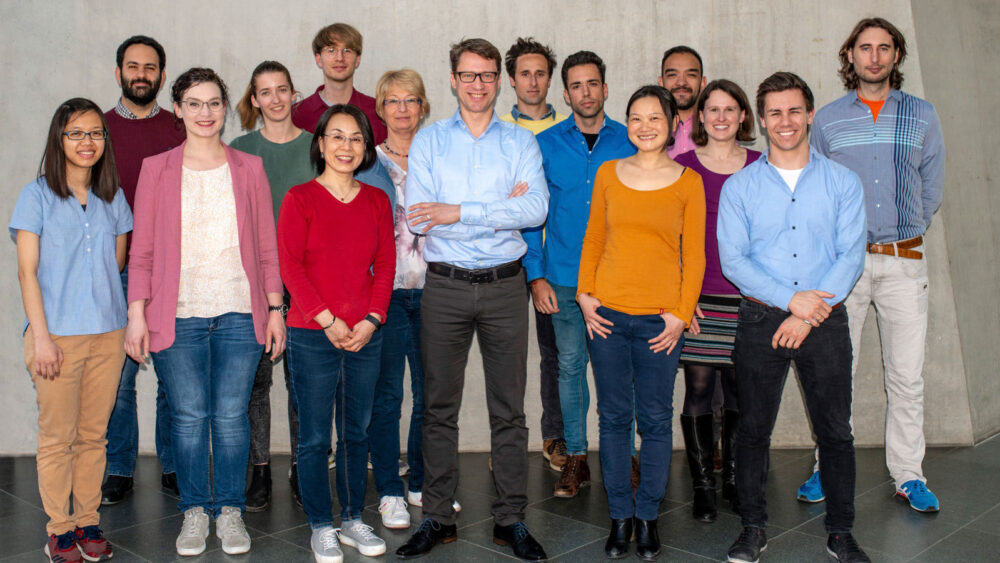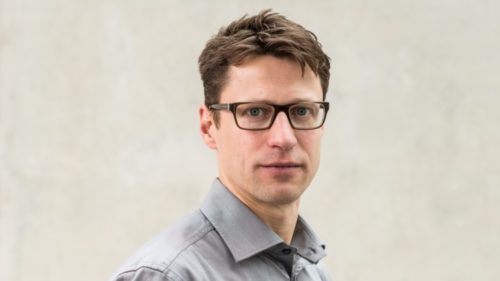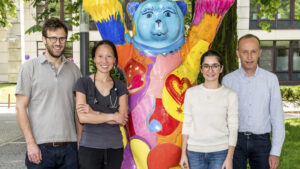

Löhning lab
We aim to biologically regenerate cartilage by selection and reprogramming of chondrocytes
Pitzer Laboratory of Osteoarthritis Research
The Pitzer Laboratory of Osteoarthritis Research investigates the cellular and molecular mechanisms leading to the development of osteoarthritis (OA). OA is the most frequently occurring joint disease among adults worldwide, it leads to progressive cartilage loss and is often accompanied by inflammatory processes. Recent studies indicate dysfunctional molecular signaling within the cartilage-producing cells of the joints, the chondrocytes. So far, the chondrocytes’ in situ biology is not well understood.
Chondrocytes reside in the joint cartilage layers in different arrangements and with varying types of metabolism. It is not clear yet whether this points to a homogenous population or to differentiated subtypes. Using a 3D-culture system of human chondrocytes that simulates a hypoxic environment, we could show that the activation of specific immune-related receptors leads to impaired cartilage production and altered metabolic activity. Now we investigate a possible connection to the development or progression of OA. Here, our group’s accumulated knowledge on the (re-) programming of T cell subtypes will be transferred to chondrocytes and the field of OA research.
Since we consider the joint as a functional unit, we also analyse the cells building up the bone mass and vascular system. In addition, we examine the infrapatellar fat pad, synovial tissue, and synovial fluid of the material from primary human donors we receive from our colleagues at the Center for Musculoskeletal Surgery of the Charité. After assessing the active genes in specific cell subtypes, we identified a candidate gene that could prove to be important for the therapy of painful ossification processes and osteophyte formation in OA.
In previous studies, we identified central cytokines and key transcription factors controlling the differentiation of T cells into subtypes (Bonilla et al., Science 2012; Peine et al., PLoS Biol. 2013; Baumann et al., PNAS 2015; Peine et al., Trends Immunol. 2016) and used this understanding of molecular processes to reprogram mature T cells into new stable phenotypes with additional functions (Hegazy et al., Immunity 2010). More recently, we showed a quantitative cytokine memory in individual cells. This means that a cell memorizes and stably maintains its individual production amount of a given cytokine (Helmstetter et al., Immunity 2015). We suggest that chondrocytes feature similar subtypes, differentiation programs, and possibilities of reprogramming. Ultimately, we want to reprogram the chondrocyte phenotypes that lead to the development of OA in patients in such a way as to achieve a long-lasting cartilage build-up.
Keywords
Osteoarthritis pathogenesis
Chondrocyte differentiation
Bone cell development
Bone angiogenesis
Lymphocyte differentiation
Immunological memory

Group leader
Univ.Prof. Dr. rer. nat. Max Löhning
Scientists
Dr. Ping Shen
Dr. Philippe Saikali
Dr. Tobias Brunner
PhD students
Nayar Alejandro Durán Hernández
Jelizaveta Fadejeva
Yujie Dai
Xiaohui Liu
Xu Liang
Shilei Wu
Technicians
Peihua Wu
Vivien Holecska
| Hegazy, A.N., C. Peine, D. Niesen, I. Panse, Y. Vainshtein, C. Kommer, Q. Zhang, T.M. Brunner, M. Peine, A. Fröhlich, N. Ishaque, R.M. Marek, J. Zhu, T. Höfer & M. Löhning. Plasticity and lineage commitment of individual Th1 cells are determined by stable T-bet expression quantities. Science Advances 2024, 10:eadk2693. doi: 10.1126/sciadv.adk2693.
This paper shows that stably maintained amounts of T-bet in individual Th1 cells determine whether the cells are fully committed or can be reprogramed into a ‘Th1+Th2’ hybrid cell subset.
Brunner*, T.M., S. Serve*, A.F. Marx, J. Fadejeva, P. Saikali, M. Dzamukova, N. Durán-Hernández, C. Kommer, F. Heinrich, P. Durek, G.A. Heinz, T. Höfer, M.F. Mashreghi, R. Kühn, D.D. Pinschewer & M. Löhning. A type 1 immunity-restricted promoter of the IL-33 receptor gene directs antiviral T-cell responses. Nature Immunology 2024, 25:256-267. doi.: 10.1038/s41590-023-01697-6. (*Shared first authors). [Paper of the Months of Charité Faculty Board, March 2024] This paper reports on the discovery and function of a novel promoter of the IL-33 receptor gene that drives its expression selectively in type 1 immune responses.
Shen, P., S. Serve, P. Wu, X. Liu, Y. Dai, N. Durán-Hernández, D.T.M. Nguyen, M. Fuchs, T. Maleitzke, M.J. Reisener, M. Dzamukova, K. Nussbaumer, T.M. Brunner, Y. Li, V. Holecska, G.A. Heinz, F. Heinrich, P. Durek, G. Katsoula, C. Gwinner, T. Jung, E. Zeggini, T. Winkler, M.F. Mashreghi, M. Pumberger, C. Perka & M. Löhning. NOS inhibition reverses TLR2-induced chondrocyte dysfunction and attenuates age-related osteoarthritis. Proceedings of the National Academy of Sciences USA 2023, 120:e2207993120. doi: 10.1073/pnas.2207993120. This paper shows that in chondrocytes from osteoarthritis patients, degradation products of extracellular matrix of joint cartilage stimulate Toll-like receptors (TLR) and trigger a cartilage-degenerative program through induction of nitric oxide synthase-2 (NOS2), which can be largely reversed by NOS inhibition in humans or Nos2 gene deficiency in mice, indicating that TLR signaling acts as a putative driver of chondrocyte dysfunction in osteoarthritis through nitric oxide induction.
Marx, A.F., S.M. Kallert, T.M. Brunner, J.A. Villegas, F. Geier, J. Fixemer, T. Abreu-Mota, P. Reuther, W.V. Bonilla, J. Fadejeva, M. Kreutzfeldt, I. Wagner, P. Aparicio-Domingo, L. Scarpellino, M. Charmoy, D.T. Utzschneider, C. Hagedorn, M. Lu, K. Cornille, K. Stauffer, F. Kreppel, D. Merkler, D. Zehn, W. Held, S.A. Luther, M. Löhning** & D.D. Pinschewer**. The alarmin interleukin-33 promotes the expansion and preserves the stemness of Tcf-1+ CD8+ T cells in chronic viral infection. Immunity 2023, 56:813-828. doi: 10.1016/j.immuni.2023.01.029. (*Shared first authors, **Shared corresponding authors). This paper identifies the alarmin IL-33 as a molecule essential for the expansion and stem-like functioning of CD8+ T cells in mice chronically infected with lymphocytic choriomeningitis virus (LCMV).
Dzamukova, M., T. Brunner, J. Miotla-Zarebska, F. Heinrich, L. Brylka, M.F. Mashreghi, A. Kusumbe, R. Kühn, T. Schinke, T. Vincent & M. Löhning. Mechanical forces couple bone matrix mineralization with inhibition of angiogenesis to limit adolescent bone growth. Nature Communications 2022, 13:3059. doi: 10.1038/s41467-022-30618-8. [Avrion-Mitchison-Prize for Rheumatology to Maria Dzamukova, Dec. 2022] This paper shows that body weight-associated mechanical loading triggers the mechanoreceptor PIEZO1 to enhance the expression of FAM20C kinase and mediate a burst in secretion of dentin matrix protein 1 (DMP1) by osteoblasts, which inhibits signalling of vascular endothelial growth factor and transforms highly angiogenic type H vessels into quiescent type L vasculature to limit bone growth activity. |
University of Colorado, Denver, CO, USA:
Prof. Dr. Charles A. Dinarello
Kennedy Institute of Rheumatology, University of Oxford, UK:
Prof. Dr. Fiona Powrie
Prof. Dr. Tonia Vincent
Dr. Anjali Kusumbe
NIH, NIAID, Bethesda, MD, USA:
Dr. Jinfang Zhu
Dr. Dragana Janković
University of Tokyo, Japan:
Prof. Dr. Susumu Nakae
Chiba University, Japan:
Prof. Dr. Toshinori Nakayama
ETH & Universitätsspital Zürich, Schweiz:
Prof. Dr. Rolf M. Zinkernagel
Prof. Dr. Hans Hengartner
Universität Basel, Schweiz:
Dr. Weldy Bonilla
Prof. Dr. Daniel D. Pinschewer
Prof. Dr. Mike Recher
Universität Genf, Schweiz:
Prof. Dr. Doron Merkler
Kantonsspital St. Gallen, Schweiz:
Prof. Dr. Lukas Flatz
Universität Lausanne, Schweiz:
Prof. Dr. Sanjiv Luther
Research Center for Molecular Medicine of the Austrian Academy of Science, Wien, Österreich:
Dr. Andreas Bergthaler
Dr. Rolf M. Schwiete Forschungsbereich für Arthrose, Orthopädische Universitätsklinik Friedrichheim, Frankfurt am Main:
Prof. Dr. Andrea Meurer
Prof. Dr. Frank Zaucke
Dr. Anna Rapp
Zentrum für Traumaforschung – Universität Ulm (ZfT Ulm):
Prof. Dr. Anita Ignatius
Institute of Translational Genomics, Helmholtz Zentrum München:
Prof. Dr. Eleftheria Zeggini
Universitätsklinikum Essen:
Prof. Dr. Karl S. Lang
Universität Düsseldorf:
Prof. Dr. Philipp A. Lang
Deutsches Krebsforschungszentrum (DKFZ), Heidelberg:
Prof. Dr. Thomas Höfer
Dr. Christoph Kommer
Dr. Qin Zhang
Systembiology der Entzündung, Universität Bonn:
Prof. Dr. Kevin Thurley
Bundesinstitut für Risikobewertung, Deutsches Zentrum zum Schutz von Versuchstieren (BfR/Bf3R), Berlin:
Dr. Frank Schulze
Tierklinik Bad Langensalza, Forschungszentrum für Medizintechnik und Biotechnologie (fzmb GmbH):
Dr. Dirk Barnewitz
FU Berlin, Veterinärmedizin:
Prof. Dr. Susanne Hartmann
Dr. Sebastian Rausch
MPI für Infektionsbiologie, Berlin:
Prof. Dr. Stefan Kaufmann
Prof. Dr. Arturo Zychlinsky
Dr. Nikolaus Deigendesch
Dr. Andreas Kupz
Charité – Universitätsmedizin Berlin:
Prof. Dr. Gerd-Rüdiger Burmester
Prof. Dr. Frank Buttgereit
Prof. Dr. Dr. Ahmed N. Hegazy
Prof. Dr. Carsten Perka
Prof. Dr. Georg Duda
Prof. Dr. Tobias Winkler
Prof. Dr. Frank Konietschke
Prof. Dr. Joachim Spranger
PD Dr. Thomas Bobbert
PD Dr. Katharina Schmidt-Bleek
PD Dr. Matthias Pumberger
PD Dr. Tobias Jung
Dr. Michael Fuchs
Dr. Tazio Maleitzke
Dr. Clemens Gwinner
Marie-Jacque Reisener
Dr. Timo Gaber
Dr. Annemarie Lang
Dr. Melba Muñoz
PD Dr. Anja Kühl
Prof. Dr. Marcus Maurer
Prof. Dr. Martin Metz
Prof. Dr. Hans-Dieter Volk
Prof. Dr. Margitta Worm
Miltenyi Biotec, Bergisch Gladbach:
Dr. Mario Assenmacher
Dr. Andreas Bosio
Dr. Anne Richter
- Willy Robert Pitzer Stiftung: Pitzer-Labor Arthroseforschung
- DFG-Projekt LO 1542/5-1
- DFG-Projekt LO 1542/4-1
- BMBF-Projekt 01KC2011C im Verbundvorhaben PROOF-DESFERAL – Präklinische, konfirmatorische Studie zur Beschleunigung der Knochenheilung und Behandlung von Frakturheilungsstörungen mit Deferoxamin
- ECRT Einstein Kickbox-Young Scientists – Förderperiode 2021:
Ketone bodies and their derivates in Type 1 Diabetes (T1D): a secondary clinical manifestation or a perpetrator of the disease? (Adrian Madrigal, Valerie Plajer, Mikie Phan) - ECRT Einstein Kickbox-Young Scientists – Förderperiode 2020:
Phenotype and transcriptional landscape of T cells in acute and chronic joint inflammation (Caroline Peine, Nayar Durán, Tazio Maleitzke, Philipp Burt) - ECRT Einstein Kickbox-Young Scientists – Förderperiode 2020:
Developing menstrual blood–derived mesenchymal stem cell transplantation as an anti-inflammatory and proregenerative therapy for osteoarthritis (Ping Shen, Max Löhning, Hans-Dieter Volk, Tobias Winkler, Tazio Maleitzke, Lisa Grunwald)

 Deutsch
Deutsch

